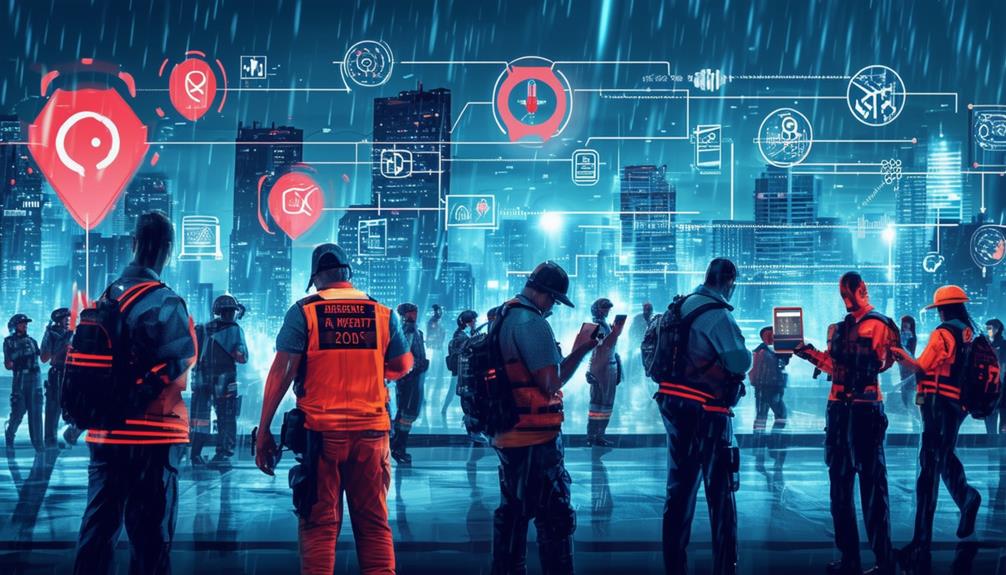Communication Strategies: Staying Connected During Chaos

During chaotic times, staying connected is crucial for stability and support. Prioritize clear, concise communication and use multiple channels like phone calls, texts, and video chats to ensure timely information dissemination.
Leverage technology, such as mobile apps and automated calling systems, to relay critical updates efficiently. Beyond tools, focus on building community engagement and trust through consistent communication. How can you effectively foster this network and maintain resilience amidst the turmoil?
Importance of Staying Connected

Staying connected during chaotic times can significantly reduce feelings of isolation and enhance your emotional well-being. Effective communication is key to maintaining these vital connections. When life becomes turbulent, reaching out to friends, family, or social networks can make a notable difference; you don't have to navigate it alone. A quick call, text, or social media message can remind you that others are there to support you.
Research underscores the importance of social connections for mental health and resilience. By staying connected, you create an environment more conducive to coping with stress. A strong social network provides a sense of belonging and emotional stability, both essential when facing chaos.
Moreover, effective communication allows you to express your feelings and concerns, enabling others to understand and support you better. This mutual understanding strengthens relationships and lays a solid foundation for emotional well-being.
Therefore, make it a priority to stay in touch with those who matter. Whether through regular meet-ups, virtual hangouts, or simple check-ins, these connections can greatly enhance your ability to manage challenging situations.
Human Connection for Well-being
Human connection is essential for emotional well-being and stress reduction, especially during chaotic times. Positive interactions with others foster a sense of calm and support, aiding in navigating uncertainty. Effective communication is crucial in building these connections. By actively listening and sharing thoughts and feelings, you cultivate a supportive environment that significantly reduces stress.
Maintaining connections with friends, family, or colleagues enhances emotional stability and provides a sense of belonging. This connection extends beyond physical presence to emotional availability. Regular check-ins through calls, texts, or video chats can help you feel grounded and supported.
Additionally, human connection creates a network of support that boosts overall well-being. Knowing someone is there for you increases emotional resilience, helping you cope better with surrounding chaos. It's important to reach out and be there for others, fostering mutual well-being. Effective communication and staying connected are key tools for emotional grounding in turbulent times.
Effective Self-Connection Practices

Developing effective self-connection practices can significantly enhance your emotional well-being during turbulent times. Start by cultivating self-awareness, which is crucial for managing stress and maintaining balance.
Mindful breathing techniques are an excellent way to improve relaxation and self-awareness, helping you stay grounded. Spending just a few moments each day focused on your breath can reduce chaos and foster a sense of calm.
Another important practice is speaking kindly to yourself. Positive self-talk can elevate your self-esteem and overall positivity, greatly contributing to emotional stability. In times of chaos, it's easy to be harsh on yourself, but remember that kindness begins within.
Focusing on the positive aspects of your life can also transform your energy and mindset. Instead of getting lost in negative news or endless social media scrolls, take time to reflect on what's going well. This shift in focus helps nurture a sense of calm and balance, even when external circumstances are turbulent.
Centeredness During Chaos
Finding centeredness during turmoil requires intentional practices that anchor you to the present moment. Grounding techniques, such as focusing on your body and surroundings, help you stay connected to the here and now, minimizing overwhelming feelings. Mindful breathing exercises, involving deep and deliberate breaths, can aid in relaxation and refocus your mind.
Positive self-talk is crucial. It promotes self-awareness and helps maintain a centered mindset. During turmoil, your internal dialogue can either add to the stress or help mitigate it. Choose words that uplift and support you.
Establishing human connections and support systems is essential. Sharing your thoughts and feelings with trusted individuals can provide a sense of stability and calm. A solid communication plan with your support network ensures you're never alone, even in turbulent times.
Lastly, practicing gratitude and focusing on positive aspects can significantly impact your ability to stay balanced. Reflecting on what you're thankful for shifts your focus away from the turmoil and cultivates a more centered and resilient mindset.
Emergency Communication Strategies

Implementing robust emergency communication strategies ensures you remain connected and informed during crises. A multi-channel approach provides redundancy, so if one method fails, others can still convey critical information. Employing methods such as text alerts, social media updates, and community bulletin boards reduces the risk of a single point of failure.
Clear and concise messaging is essential. In an emergency, people need to understand your message quickly and act on it immediately. Avoid jargon and use simple, direct language. Pre-established communication protocols streamline efforts, ensuring everyone knows their role and the steps to follow during a crisis.
Technology is pivotal for efficient emergency communication. Utilize mobile apps, automated calling systems, and online platforms to disseminate information swiftly. Community engagement is key to fostering resilience. Regular interaction with your community builds trust and ensures people are more likely to respond to critical communications when it matters most.
Conclusion
During chaotic times, maintaining connection is crucial for stability and well-being. Use clear messaging and multiple channels like calls, texts, and video chats to keep everyone informed. Leverage technology, such as mobile apps and automated systems, to provide timely updates. Consistent communication builds trust and fosters a supportive network, enabling your community to navigate challenges together. Staying connected enhances resilience and a sense of unity.




